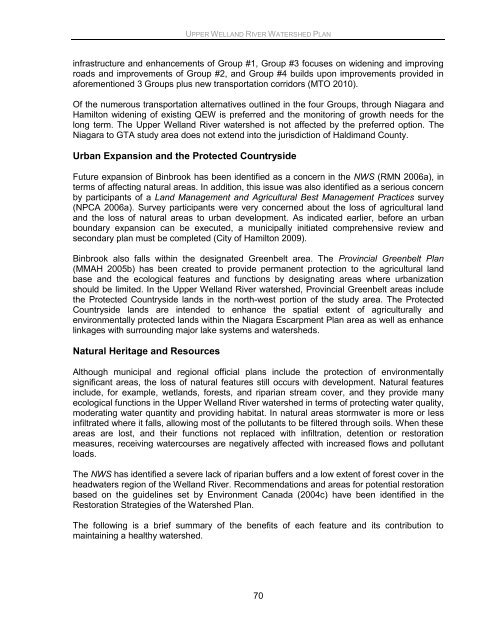Upper Welland River Watershed Plan - Niagara Peninsula ...
Upper Welland River Watershed Plan - Niagara Peninsula ...
Upper Welland River Watershed Plan - Niagara Peninsula ...
You also want an ePaper? Increase the reach of your titles
YUMPU automatically turns print PDFs into web optimized ePapers that Google loves.
UPPER WELLAND RIVER WATERSHED PLANinfrastructure and enhancements of Group #1, Group #3 focuses on widening and improvingroads and improvements of Group #2, and Group #4 builds upon improvements provided inaforementioned 3 Groups plus new transportation corridors (MTO 2010).Of the numerous transportation alternatives outlined in the four Groups, through <strong>Niagara</strong> andHamilton widening of existing QEW is preferred and the monitoring of growth needs for thelong term. The <strong>Upper</strong> <strong>Welland</strong> <strong>River</strong> watershed is not affected by the preferred option. The<strong>Niagara</strong> to GTA study area does not extend into the jurisdiction of Haldimand County.Urban Expansion and the Protected CountrysideFuture expansion of Binbrook has been identified as a concern in the NWS (RMN 2006a), interms of affecting natural areas. In addition, this issue was also identified as a serious concernby participants of a Land Management and Agricultural Best Management Practices survey(NPCA 2006a). Survey participants were very concerned about the loss of agricultural landand the loss of natural areas to urban development. As indicated earlier, before an urbanboundary expansion can be executed, a municipally initiated comprehensive review andsecondary plan must be completed (City of Hamilton 2009).Binbrook also falls within the designated Greenbelt area. The Provincial Greenbelt <strong>Plan</strong>(MMAH 2005b) has been created to provide permanent protection to the agricultural landbase and the ecological features and functions by designating areas where urbanizationshould be limited. In the <strong>Upper</strong> <strong>Welland</strong> <strong>River</strong> watershed, Provincial Greenbelt areas includethe Protected Countryside lands in the north-west portion of the study area. The ProtectedCountryside lands are intended to enhance the spatial extent of agriculturally andenvironmentally protected lands within the <strong>Niagara</strong> Escarpment <strong>Plan</strong> area as well as enhancelinkages with surrounding major lake systems and watersheds.Natural Heritage and ResourcesAlthough municipal and regional official plans include the protection of environmentallysignificant areas, the loss of natural features still occurs with development. Natural featuresinclude, for example, wetlands, forests, and riparian stream cover, and they provide manyecological functions in the <strong>Upper</strong> <strong>Welland</strong> <strong>River</strong> watershed in terms of protecting water quality,moderating water quantity and providing habitat. In natural areas stormwater is more or lessinfiltrated where it falls, allowing most of the pollutants to be filtered through soils. When theseareas are lost, and their functions not replaced with infiltration, detention or restorationmeasures, receiving watercourses are negatively affected with increased flows and pollutantloads.The NWS has identified a severe lack of riparian buffers and a low extent of forest cover in theheadwaters region of the <strong>Welland</strong> <strong>River</strong>. Recommendations and areas for potential restorationbased on the guidelines set by Environment Canada (2004c) have been identified in theRestoration Strategies of the <strong>Watershed</strong> <strong>Plan</strong>.The following is a brief summary of the benefits of each feature and its contribution tomaintaining a healthy watershed.70
















